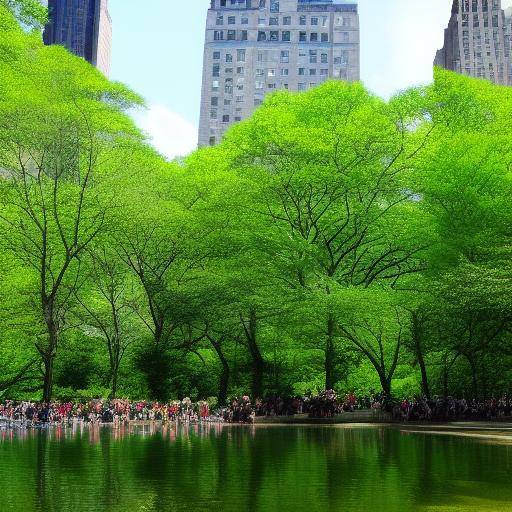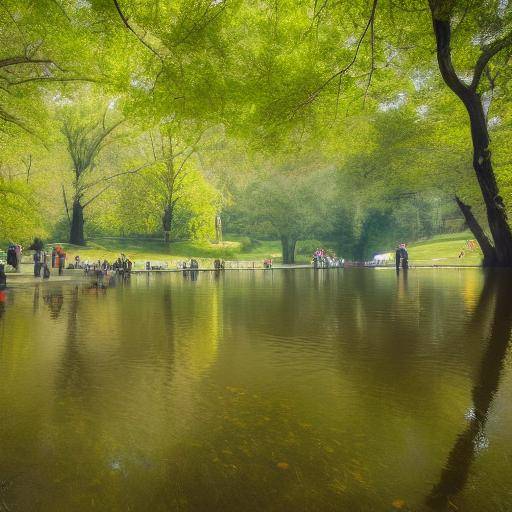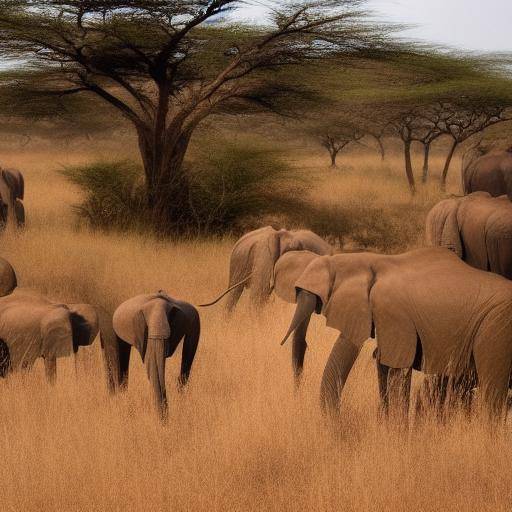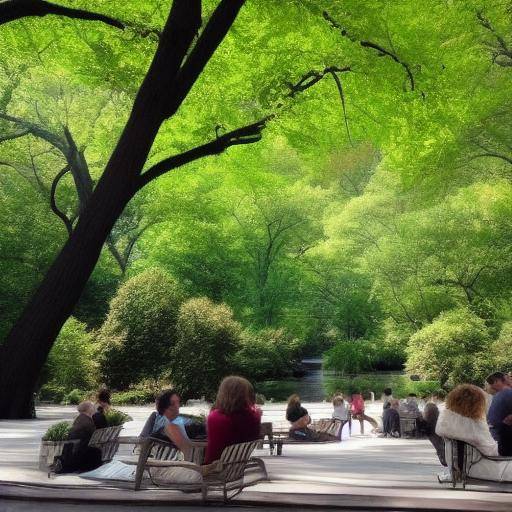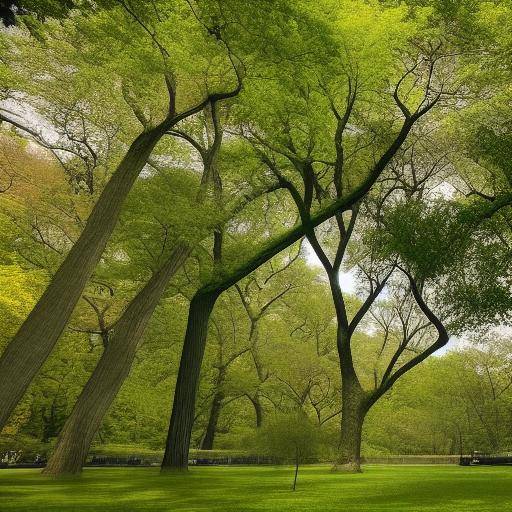
Central Park is an iconic urban oasis located in the heart of Manhattan, New York. This natural wonder not only offers New Yorkers a peaceful refuge of the city's hustle, but also provides invaluable lessons on urban wildlife, conservation and environmental education. In this article, we will explore the fascinating interaction between fauna, flora and conservation in Central Park, highlighting its educational importance and its impact on the urban environment. From the history of this emblematic park to future trends, we will discover the valuable lessons we can learn from this natural space in the middle of the metropolis. Join us on this extraordinary journey of learning and discovery!
Introduction
Central Park, a green lung of 341 hectares in the heart of Manhattan, is much more than a world-renowned tourist destination. This green space represents a constantly evolving ecosystem, home to an amazing diversity of flora and fauna, and a key cultural treasure for New York City. In addition, Central Park plays a crucial role in promoting environmental education and awareness of nature conservation in an urban environment.
As we enter the natural lessons of Central Park, we will embark on a journey that will take us from its intriguing history and evolution to the practical applications that influence the future of urban wildlife and conservation. Join us while exploring in detail how this emblematic space teaches valuable lessons about coexistence, sustainability and coherence with our natural environment.
In order to provide a comprehensive analysis based on current data, interviews with experts and case studies, we will get into the natural lessons of Central Park, addressing its historical significance, current challenges, practical applications, future perspectives and much more.
History and Background
Central Park, inaugurated in 1858, is one of the most remarkable creations in the history of urbanism. Designed by Frederick Law Olmsted and Calvert Vaux, this park was conceived as a green space that offered a shelter of urban life, while fostering the encounter between nature and the community. During its more than 160 years of existence, Central Park has evolved significantly, facing challenges and transformations that reflect New York's history and development.
Origins and Evolution
The emergence of Central Park took place at a crucial time for New York, when the city experienced a dizzying growth and urbanization. The need for a natural oasis became imperative to counter the effects of industrialization and urban development.
In 1853, an extensive area of land was designated for the creation of the park, and a design contest was convened that resulted in the revolutionary vision of Olmsted and Vaux. The construction of the park, which involved the meticulous manipulation of the land and the introduction of representative plant species from different regions of the country, marked the beginning of a unique relationship between nature and urbanization.
Significant Milestones and Developments
During its history, Central Park has been the scene of numerous significant events that have marked its evolution. From the creation of its artificial lakes and gardens, to the restoration of degraded or destroyed natural spaces, the park has witnessed a continuous effort to preserve its natural beauty and its ecological wealth.
Deep analysis
The deep relationship between wildlife, environmental education and conservation in Central Park offers an invaluable perspective on the challenges and benefits of interaction between nature and the urban environment. Through a detailed analysis, we explore the complex dynamics that define these interrelations and their impact on our understanding of urban wildlife and environmental conservation.
Benefits and Challenges
The presence of a natural environment in the middle of a large city like New York offers multiple benefits, from improving air quality to promoting biodiversity. Environmental education derived from Central Park provides visitors, residents and students with a unique opportunity to appreciate the importance of nature conservation in an urban context, while facing challenges such as wildlife management in a highly populated environment.
Educational programmes and conservation activities play a crucial role in the protection and promotion of wildlife, while fostering understanding and appreciation for nature in an urban context.
Current trends
Urban wildlife and environmental conservation continue to evolve in Central Park as innovative measures are being implemented to address current challenges. From the management of invasive species to the promotion of sustainable practices, the park has become a leading example of how environmental education can inspire effective conservation initiatives that positively impact the urban environment.
The growing awareness of the importance of wildlife and conservation in urban environments has led to increased collaboration between environmental organizations, academic institutions and government, generating a dynamic movement towards the sustainability and protection of urban ecosystems.
Comprehensive review
The natural lessons of Central Park transcend their mere existence as an urban park, covering practical applications that influence the present and future of urban wildlife and conservation. This section will focus on exploring how the learnings derived from this emblematic green space translate into tangible actions that shape the relationship between the human population and its natural environment.
Applications and Best Practices
Central Park has established an exemplary model in the integration of educational and conservation programs that translate into significant actions. From the restoration of natural habitats to the implementation of species monitoring programs, the park is a breeding ground for best practices in wildlife management and the promotion of environmental education.
Expert Perspectives and Vision Futura
The experience accumulated in Central Park has generated a wealth of expert perspectives that project a promising future for urban wildlife and conservation. Experts in the field of urban ecology, biodiversity conservation and environmental education offer visions that highlight the importance of integrating these aspects into urban environments to foster harmonious coexistence between nature and society.
Comparative analysis
The comparison between Central Park, environmental education and urban wildlife allows us to identify similarities, differences and opportunities for synergy that enrich our understanding of these concepts.
Similarities and Variances
While Central Park is an iconic example of a natural space in an urban environment, its approach to environmental education and conservation presents significant similarities and differences with other urban natural spaces around the world. The detailed understanding of these similarities and differences gives us a broader view on how to address the common and unique challenges associated with urban wildlife and conservation.
Practical Tips and Accessible Recommendations
Understanding Central Park's natural lessons gives us the opportunity to translate these knowledge into tangible actions that foster harmonious coexistence between wildlife and the urban community. Here we present practical advice and actionable recommendations to promote environmental education and conservation in urban environments.
- Participates in volunteer programs for the conservation of local parks.
- Learn about urban wildlife through tours and guided activities in urban parks.
- It supports environmental education and conservation initiatives through donations to non-profit organizations.
- It promotes awareness of the importance of urban wildlife in the community through educational events and awareness-raising campaigns.
These practical councils offer specific starting points to actively engage in the promotion of urban wildlife and conservation in the urban environment.
Industrial Perceptions and Expert Reviews
Perceptions of opinion leaders and experts in urban wildlife and conservation in urban environments provide a valuable understanding of the challenges and opportunities facing this constantly evolving field.
By analyzing the current landscape and emerging trends in urban wildlife and conservation, these perspectives provide a deep insight into the current state and potential future of these vital aspects of the urban environment.
Case Studies and Real Life Applications
Through detailed case studies, we will explore the practical applications of Central Park's natural lessons in real life. These cases will provide concrete examples of how the principles of environmental education and conservation translate into tangible initiatives that positively impact urban wildlife.
Future Trends and Predictions
The future of urban wildlife and conservation in urban environments is shaped by emerging trends and predictions based on experience and research. We will analyze current trends and projections to the future, providing a complete insight into the direction this key area is taking.
Conclusions and FAQs
Conclusion
Central Park is not only an emblematic park, but also a beacon of valuable lessons on urban wildlife, environmental education and conservation. Its rich legacy and influence in the urban environment offer a solid starting point to understand how natural spaces can play a crucial role in promoting sustainability and ecological balance in an urban environment.
Frequently asked questions
1. How has Central Park influenced environmental awareness in Manhattan?
Central Park has been instrumental in promoting environmental awareness in Manhattan by serving as a model of coexistence between nature and urban life, stimulating sensitivity to the importance of preserving green spaces in urban environments.
2. What are some educational programs related to urban wildlife in Central Park?
Central Park offers a variety of educational programs on urban wildlife, including guided tours, bird watching activities, and workshops on the importance of biodiversity in urban environments.
3. What challenges does Central Park face in the conservation of its wildlife?
Central Park faces challenges such as the balance between the conservation of native species and the management of invasive exotic species, the preservation of natural habitats and the impact of urbanization on wildlife.
4. How can we contribute to the conservation of urban wildlife from our communities?
Communities can contribute to the conservation of urban wildlife through participation in volunteer activities, support for environmental education and conservation programmes, and the promotion of sustainable practices in urban settings.
5. What future trends are anticipated in the conservation of urban wildlife?
Future trends in urban wildlife conservation are expected to include a more holistic approach to urban ecosystem management, the development of urban green corridors and the promotion of community participation in the conservation and promotion of urban wildlife.
6. What is the role of Central Park as an example of urban wildlife and conservation for other cities?
Central Park is a benchmark for other cities by demonstrating how a natural space can coexist and prosper in an urban environment, setting a precedent for the conservation of urban wildlife around the world.
Throughout this journey, we have explored natural lessons in Central Park, highlighting its impact on environmental education, urban wildlife and conservation. From its history and evolution to future trends, Central Park continues to exert a transformative influence on our understanding of the interaction between nature and urbanization.
As we continue to promote the harmony between urban life and the preservation of nature, the lessons of Central Park inspire us to adopt a more conscious and sustainable approach in the management of our urban environments, promoting harmonious coexistence between wildlife, the community and the city.
Learn more about the fascinating interaction between wildlife, environmental education and conservation in Central Park, and join in promoting a more sustainable and balanced future in our urban environments!
Sources:
- Central Park Conservancy - Official Website
- National Geographic - Central Park: The Complete Guide
- New York City Department of Parks " Recreation - Central Park History
This article has been an in-depth exploration of natural lessons in Central Park, and we hope it has provided a sound and enriching understanding of the interaction between wildlife, environmental education and conservation in urban environments.

